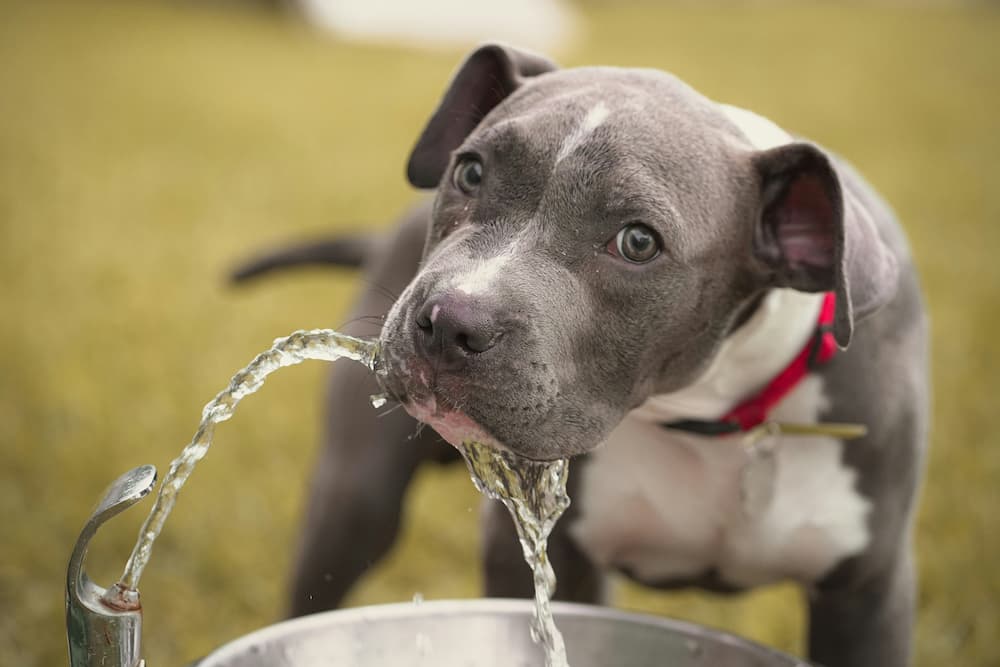Is your dog acting restless, licking its lips excessively, or turning away from its favorite meal? At first it might seem minor, but these signs could indicate dog nausea – a queasy upset stomach in dogs. Recognizing canine nausea in your dog is crucial to getting them help. This article will explain common dog nausea symptoms, possible causes, and steps you can take for treating nausea in dogs. We’ll also cover when to consult a vet and tips to prevent future episodes, so you can keep your pup happy and healthy. For any concerned new dog owner, understanding these basics can offer peace of mind.

What are Signs of Nausea in Dogs?
Unlike humans, dogs can’t tell us when they feel sick. It’s up to us to recognize the subtle behavioral and physical changes that indicate canine nausea. Knowing how to recognize nausea in dogs is crucial for providing timely help.
Common signs include:
Excessive Lip Licking and Drooling: One of the most classic signs of a nauseous dog. You might notice them smacking their lips or drooling more than usual.
Loss of Appetite: A sudden disinterest in food or treats is a major red flag.
Swallowing Repeatedly: This is your dog’s attempt to manage excess saliva and combat the sick feeling.
Lethargy and Depression: A nauseous dog may become unusually quiet, withdrawn, and lack energy for play or walks.
Pacing and Restlessness: They may seem unable to get comfortable, pacing around and shifting positions frequently.
Vocalizing: Some dogs may whine or groan when they feel unwell.
Seeking Seclusion: Your normally social pup might hide under furniture or in a quiet corner.
It’s important to note that a dog can feel nauseous without actually vomiting. A dog nauseous but not throwing up might show many of these signs, which can sometimes be more difficult to identify.
What Causes Dog Nausea?
Understanding the root cause of your dog’s discomfort is key to effective treatment. The triggers for dog nausea range from simple, fleeting issues to more serious medical conditions. common causes include:
Dietary Indiscretion: This is the top cause. It refers to a dog eating something they shouldn’t, such as garbage, spoiled food, table scraps, or foreign objects.
Motion Sickness: Many dogs experience nausea during car rides due to the conflicting signals between their eyes and inner ear.
Medication Side Effects: Certain drugs, including some antibiotics and pain medications, can upset a dog’s stomach.
Empty Stomach (Bilious Vomiting Syndrome): When a dog’s stomach is empty for too long, bile can accumulate and irritate the stomach lining, leading to nausea, often seen in the early morning.
Infections: Viral or bacterial infections, such as parvovirus or gastritis, can cause significant gastrointestinal upset.
Parasites: Intestinal worms can irritate the stomach and intestines.
Underlying Medical Conditions: Chronic issues like kidney disease, liver problems, pancreatitis, or certain cancers can have nausea as a primary symptom.
Stress and Anxiety: Just like in people, high stress levels can trigger stomach upset in dogs.
Because there are so many potential causes of canine nausea, finding the exact one can be tricky. If episodes repeat or are severe, your vet may need to run tests to determine the root cause.
What to Do If Your Dog Has Nausea?
For mild nausea, home care can often help your dog feel better. Here’s how to help nausea in dogs at home:
Withhold food for 12–24 hours, but continue to offer small amounts of water. This gives the stomach time to settle.
Offer bland food in small, frequent meals. A common recommendation is cooked white rice with boiled chicken (no seasoning). After 2–3 days on the bland diet and improvement, slowly transition back to regular dog food.
Small, frequent meals: Instead of one large meal, feed tiny portions several times a day. This prevents overloading the stomach.
Avoid irritants: No treats, table scraps, or grass during recovery. Grass might induce more vomiting. Keep the dog from chewing on bones or rawhides, which can upset the tummy.
Hydration: Ensure your dog drinks water. If they refuse, offer ice chips or an electrolyte solution. Dehydration worsens nausea.
Natural remedies: Ginger or peppermint can soothe nausea in humans and may help dogs too. You can sprinkle a tiny amount of powdered ginger on their food or give a pet-safe ginger treat – but only with your vet’s approval.
Quiet rest: Provide a calm, comfortable area. Reducing stress (no loud noises or activity) lets the dog’s body recover.
Medication (veterinarian guidance): Do not give human anti-nausea meds (like Pepto-Bismol) unless your vet says so. If needed, vets may prescribe a dog-safe antiemetic such as maropitant (Cerenia)or metoclopramide. These drugs can stop nausea and vomiting effectively.
In short, the key to treating nausea in dogs at home is rest and gentle feeding. PetMD advises that if your dog seems more comfortable within a few hours and doesn’t vomit, the problem often resolves on its own. However, closely monitor your pet during this time.

When Should I Take My Dog to the Vet for Nausea?
While mild nausea can often be managed at home, certain signs indicate a need for immediate veterinary attention. Don’t wait to see a vet if your nauseous dog exhibits any of the following:
Nausea persists for more than 24 hours despite home care.
You suspect they ingested a toxin (e.g., chocolate, xylitol, grapes, rat poison).
You know they swallowed a foreign object (e.g., toy, sock, bone).
Nausea is accompanied by vomiting blood or material that looks like coffee grounds.
Diarrhea is present, especially if it’s bloody.
Your dog shows signs of abdominal pain (whining, trembling, a tense or swollen belly, or a “praying” position with front legs down).
Your dog becomes lethargic, weak, or collapses.
Signs of dehydration are present (dry gums, loss of skin elasticity, sunken eyes).
Your dog has a pre-existing medical condition like diabetes, kidney disease, or is a senior.
A dog’s nausea can quickly lead to dehydration and electrolyte imbalances, making prompt professional care essential in severe cases.
How to Prevent Nausea in Dogs?
Prevention is always better than cure. While you can’t prevent every case, you can significantly reduce the frequency of your dog’s stomach upsets with a few proactive strategies.
Diet Management: Feed a consistent, high-quality diet. Avoid sudden changes in food; if a switch is needed, transition gradually over 7-10 days. Resist the urge to feed fatty table scraps.
Prevent Scavenging: Keep garbage cans securely closed and be vigilant on walks to prevent your dog from eating things off the ground.
Regular Feeding Schedule: Feed your dog two or three smaller meals a day rather than one large one. This helps prevent their stomach from becoming empty and irritated, which is key for dogs prone to bilious vomiting syndrome.
Manage Motion Sickness: If your dog gets car sick, talk to your vet about safe anti-nausea medication. Make car rides positive by taking short trips to fun places and ensuring good ventilation.
Parasite Prevention: Stay up-to-date on deworming and year-round heartworm prevention, as some parasites can cause GI distress.
Reduce stress: Anxiety can upset a dog’s stomach. Keep your pet’s routine calm and give them plenty of exercise and mental stimulation.
“Puppy-Proof” Your Home: Keep toxins (cleaning supplies, human medications, certain plants) and small objects that could be swallowed out of your dog’s reach.
Regular Vet Check-ups: Annual wellness exams can help catch underlying conditions (like kidney or liver issues) before they become severe and cause chronic nausea.

Conclusion
Understanding dog nausea means knowing the symptoms and causes, so you can act quickly. Keep an eye out for dog nausea symptoms like drooling, lip-licking, or reluctance to eat. For mild cases, simple home care (fluids and a bland diet) often makes them better. But if your dog’s nausea is severe or lasts more than a day, err on the side of caution and seek veterinary help. Remember, treating nausea in dogs early and preventing known triggers will help your pet recover faster and avoid future bouts. With these tips on how to help nausea in dogs and what to watch for, you’ll be prepared to keep your pup comfortable.
FAQ
Why is my dog nauseous but not throwing up?
Nausea and vomiting are two separate processes controlled by the brain. It’s very common for a dog to feel nauseous (showing signs like lip-licking and drooling) without actually progressing to vomiting. The stomach may be irritated, but not enough to trigger the full vomiting reflex. This can sometimes last for hours before either subsiding or culminating in vomit.
Can an empty stomach cause nausea in dogs?
Yes, absolutely. This is a common cause, often referred to as bilious vomiting syndrome. When a dog’s stomach is empty for a prolonged period (e.g., overnight), bile and stomach acid can build up and irritate the stomach lining, leading to nausea and often vomiting of yellow bile. Feeding smaller, more frequent meals can easily prevent this.
How long will nausea last in dogs?
The duration depends entirely on the cause. A simple case of dietary indiscretion may cause nausea that resolves within 12-24 hours with fasting and a bland diet. Nausea from a more serious condition like a foreign body obstruction, infection, or organ disease will persist and likely worsen until the underlying problem is treated by a veterinarian. If your dog’s nausea lasts more than a day, it’s time to call the vet.
Visited 1 times, 1 visit(s) today





